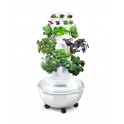Learn how nano glutathione can help you age gracefully by neutralizing harmful free radicals, supporting a robust...
Blog Search
Blog tags
7 colors on the menu
By Anne-Marie Roy
Dietitian-Nutritionist

The big stars of the moment in the field of nutrition, still unknown because they are the latest arrivals in the scientific world, are the compounds called "phytochemical elements".
Phytochemicals are natural substances that only plants produce. Each plant has its own unique combination of phytochemicals that determine its color, smell and taste. The phytochemicals in plants protect them from cellular damage caused by sunlight, insects and disease. The same phytochemicals that protect the plant also benefit our health; what is good for the plant is also good for us! It is now known that they help our body protect itself from cancer, heart disease, stroke, arthritis, aging of the brain and eyes and all sorts of degenerative diseases. To date, more than 80,000 phytochemicals have been identified and are under the scrutiny of researchers around the world. Plants have definitely not finished impressing us.
Among the phytochemicals, those that give color to plants are attracting a lot of attention from nutrition specialists. Not only is it recommended to eat 9 to 10 servings of fruits and vegetables a day to prevent cancer, but just as much importance is now placed on having the different colors of the plant color spectrum on our daily plates. If we are missing a color, we are also missing substances that are beneficial to certain organs.
So make sure you have the following seven colors on your daily menu:
RED: whose active substance is lycopene (a carotenoid) that protects us against prostate, lung and digestive cancer.
Sources: tomatoes, pink grapefruit, watermelon.
MAUVE / RED: Whose active substances are anthocyanins and polyphenols that delay cellular aging and prevent the formation of blood clots.
Sources: red and blue grapes, blueberries, strawberries, beets, eggplant, red cabbage, red bell pepper, plums, red apples, black cherries.
ORANGE: Whose active substances are alpha and beta-carotene that stimulate the immune system, help stop cell proliferation and communication between cells.
Sources: carrots, mangoes, cantaloupe, winter squash, sweet potatoes.
YELLOW /ORANGE: Whose active ingredients are beta-cryptoxanthin and hesperitin, which help prevent heart disease and certain cancers.
Sources: oranges, grapefruit, lemon, peaches, papaya, nectarines, pineapple
GREEN / YELLOW: Whose active ingredients are lutein (a carotenoid) and zeaxanthin which considerably reduce the risk of cataracts and macular degeneration (one of the major causes of blindness).
Sources: spinach, green bell pepper, kale, romaine lettuce, green peas, avocado, honeydew melon...
GREEN: whose active substances are sulforafane, isocyanates and indoles that inhibit the action of carcinogenic elements.
Sources: the cabbage family (broccoli, Brussels sprouts, kale, bok choi...)
WHITE / GREEN: Whose active substances are allicin and other sulphur compounds, quercetin and kaemperol which have anti-tumor and anti-inflammatory properties and prevent the oxidation of cholesterol.
Sources: garlic, onions, leeks, celery, asparagus, pears, green grapes...
To learn more about colors, here are two book suggestions:
«The Color Code : fruits and vegetables are stars», James A. Joseph, Daniel Nadeau and Anne Underwood
«What Color Is Your Diet?», Dr. David Heber and Susan Bowerman.
Anne-Marie Roy is a dietitian-nutritionist, consultant, speaker and writer.
annemarie_ecolo@hotmail.com




















Leave a comment
Log in to post comments